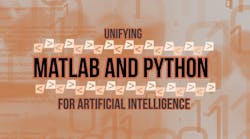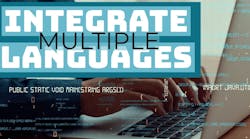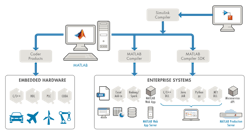Interoperability Part 1: Using Multiple Programming Languages
This video, the first of a three-part series addressing multiple-language application development, features Heather Gorr, PhD, Principal MATLAB Product Marketing Manager at MathWorks. I spoke with Heather about interoperability when dealing with application creation that uses more than one programming language (see the video above). The other two parts of the series are listed below.
Using more than one programming language is common. Examples include environments such as MATLAB and Simulink (see figure). MATLAB supports languages like C/C++ and Python. Python, which has become very popular with machine-learning/artificial-intelligence (ML/AI) tools and frameworks, can be used within the MATLAB IDE. Likewise, Jupyter, with its web-based notebook interface, supports over 40 programming languages, among them are Python and MATLAB.
Support of multiple programming languages by development tools is just the starting point. Calling code across programming languages is straightforward, but dealing with details such as data compatibility and understanding functions defined in different language libraries can be a challenge.
Using multiple programming languages and libraries has other challenges, i.e., increasing the complexity and support issues. As a result, developers need to track versions, bugs, and compatibility with multiple compilers and runtimes rather than a single set.
However, utilization of multiple programming languages offers major advantages, too. Some languages are more amendable to some types of applications while others may provide access to libraries developed for a particular language or language implementation. Certain languages provide a more concise description of various aspects of an application.
It's possible to mix and match a dozen programming languages in a single application, but that's rare. Typically, a pair of languages is more common, with one providing the primary coding platform for an application and the second programming language delivering support for a particularly useful runtime or application code. It may also involve two different language preferences of multiple developers working on a particular project.
Extension of legacy code is another reason for utilizing multiple programming languages.
Links
- MATLAB
- External Language Interfaces
- MATLAB Integration for Jupyter
- Mitsui Chemicals Deploys AI and Automation Systems with TensorFlow and MATLAB
Coding for Engineers: Advantages of Using MATLAB and Python Together
About the Author
William G. Wong
Senior Content Director - Electronic Design and Microwaves & RF
I am Editor of Electronic Design focusing on embedded, software, and systems. As Senior Content Director, I also manage Microwaves & RF and I work with a great team of editors to provide engineers, programmers, developers and technical managers with interesting and useful articles and videos on a regular basis. Check out our free newsletters to see the latest content.
You can send press releases for new products for possible coverage on the website. I am also interested in receiving contributed articles for publishing on our website. Use our template and send to me along with a signed release form.
Check out my blog, AltEmbedded on Electronic Design, as well as his latest articles on this site that are listed below.
You can visit my social media via these links:
- AltEmbedded on Electronic Design
- Bill Wong on Facebook
- @AltEmbedded on Twitter
- Bill Wong on LinkedIn
I earned a Bachelor of Electrical Engineering at the Georgia Institute of Technology and a Masters in Computer Science from Rutgers University. I still do a bit of programming using everything from C and C++ to Rust and Ada/SPARK. I do a bit of PHP programming for Drupal websites. I have posted a few Drupal modules.
I still get a hand on software and electronic hardware. Some of this can be found on our Kit Close-Up video series. You can also see me on many of our TechXchange Talk videos. I am interested in a range of projects from robotics to artificial intelligence.



